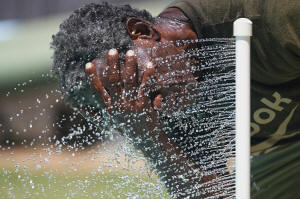Feel sticky this summer? That's because it's been record muggy East of
the Rockies
[August 11, 2025]
By SETH BORENSTEIN and M.K. WILDEMAN
More than 70 million Americans sweated through the muggiest first two
months of summer on record as climate change has noticeably dialed up
the Eastern United States' humidity in recent decades, an Associated
Press data analysis shows.
And that meant uncomfortably warm and potentially dangerous nights in
many cities the last several weeks, the National Weather Service said.
Parts of 27 states and Washington, D.C., had a record amount of days
that meteorologists call uncomfortable — with average daily dew points
of 65 degrees Fahrenheit or higher — in June and July, according to data
derived from the Copernicus Climate Service.
And that's just the daily average. In much of the East, the mugginess
kept rising to near tropical levels for a few humid hours. Philadelphia
had 29 days, Washington had 27 days and Baltimore had 24 days where the
highest dew point simmered to at least 75 degrees, which even the the
weather service office in Tampa calls oppressive, according to weather
service data.
Dew point is a measure of moisture in the air expressed in degrees that
many meteorologists call the most accurate way to describe humidity. The
summer of 2025 so far has had dew points that average at least 6 degrees
higher than the 1951-2020 normals in Washington, Baltimore, Pittsburgh,
Richmond, Columbus and St. Louis, the AP calculations show. The average
June and July humidity for the entire country east of the Rockies rose
to more than 66 degrees, higher than any year since measurements started
in 1950.
“This has been a very muggy summer. The humid heat has been way up,”
said Bernadette Woods Placky, chief meteorologist at Climate Central.

Twice this summer climate scientist and humidity expert Cameron Lee of
Kent State University measured dew points of about 82 degrees at his
home weather station in Ohio. That's off the various charts that the
weather service uses to describe what dew points feel like.
“There are parts of the United States that are experiencing not only
greater average humidity, especially in the spring and summer, but also
more extreme humid days,” Lee said. He said super sticky days are now
stretching out over more days and more land.
High humidity doesn't allow the air to cool at night as much as it
usually does, and the stickiness contributed to multiple nighttime
temperature records from the Ohio Valley through the Mid-Atlantic and up
and down coastal states, said Zack Taylor, forecast operations chief at
the National Weather Service's Weather Prediction Center. Raleigh,
Charlotte, Nashville, Virginia Beach, Va., and Wilmington, N.C., all
reached records for the hottest overnight lows. New York City, Columbus,
Atlanta, Richmond, Knoxville, Tennessee and Concord, New Hampshire came
close, he said.
“What really impacts the body is that nighttime temperature,” Taylor
said. “So if there’s no cooling at night or if there’s a lack of cooling
it doesn’t allow your body to cool off and recover from what was
probably a really hot afternoon. And so when you start seeing that over
several days, that can really wear out the body, especially of course if
you don’t have access to cooling centers or air conditioning.”
[to top of second column]
|

Paul Williams cools off in water while taking a break from yard work
in Richardson, Texas, July 31, 2025. (AP Photo/LM Otero, File)
 An extra hot and rainy summer
weather pattern is combining with climate change from the burning of
coal, oil and natural gas, Woods Placky said.
The area east of the Rockies has on average gained about 2.5 degrees
in summer dew point since 1950, the AP analysis of Copernicus data
shows. In the 1950s, 1960s, 1970s, 1980s and part of the 1990s, the
eastern half of the country had an average dew point in the low 60s,
what the weather service calls noticeable but OK. In four of the
last six years that number has been near and even over the
uncomfortable line of 65.
“It's huge,” Lee said of the 75-year trend. “This is showing a
massive increase over a relatively short period of time.”
That seemingly small increase in average dew points really means the
worst ultra-sticky days that used to happen once a year, now happen
several times a summer, which is what affects people, Lee said.
Higher humidity and heat feed on each other. A basic law of physics
is that the atmosphere holds an extra 4% more water for every degree
Fahrenheit (7% for every degree Celsius) warmer it gets,
meteorologists said.
For most of the summer, the Midwest and East were stuck under either
incredibly hot high pressure systems, which boosted temperatures, or
getting heavy and persistent rain in amounts much higher than
average, Taylor said. What was mostly missing was the occasional
cool front that pushes out the most oppressive heat and humidity.
That finally came in August and brought relief, he said.
Humidity varies by region. The West is much drier. The South gets
more 65-degree dew points in the summer than the North. But that's
changing.
University of Georgia meteorology professor Marshall Shepherd said
uncomfortable humidity is moving further north, into places where
people are less used to it.
Summers now, he said, “are not your grandparents’ summers.”
___
Borenstein reported from Washington and Wildeman reported from
Hartford, Connecticut.
All contents © copyright 2025 Associated Press. All rights reserved
 |